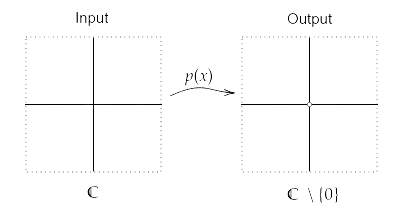Topological Proofs of Stuff and Things
I'm writing this page to serve as a collection of proofs I come across which use topological methods to show things
about non-topological-like things. I'll update this page as I come across them. I find it interesting how
topological methods are useful outside of its own discipline, or, from a different perspective, how topology lives
in a lot of nonobvious places.
Infinite Primes
This proof of a classic theorem was invented by Hillel Furstenberg in the 1950s.°
Theorem 1. There are infinitely many primes.
Proof. Define to be the arithmetic sequence . Then we can define a topology on by calling a subset open if and only if it is
the union of some arithmetic sequences. It is easy enough to show that this actually does define a topology on
. We notice two things:
- The compliment of a finite set can't be closed, because this would imply that a finite set could be open.
But the only finite open set in our topology is the empty set.
- Any arithmetic sequence is closed, since we can write the compliment of as
which is open because it is the union of arithmetic sequences.
Now suppose for the sake of contradiction that there were finitely many primes, indexed . Since any integer
can be written as the multiples of some primes, except for , we can write
Note that the left hand side isn't closed by our first bullet-point observation. But the right hand side, being the
union of finitely many closed sets, must be closed (this isn't necessarily true for infinite unions of closed sets).
This is a contradiction.
Fundamental Theorem of Algebra
This is a classic application of the fundamental group. I'll assume that one has already calculated the fundamental
group of a circle to be , even though this takes a lot of work. I won't go into rigorous detail,
but the point will be more to get a visual understanding of the proof.
Theorem 2. A degree -polynomial with complex coefficients has
roots in .
Proof.
If we show that one root of exists, say , then we can factor out to get
another polynomial in . So by some inductive argument, it suffices to show that a non-constant
polynomial has a root in .
Suppose for the sake of contradiction that has no root in . So is a function from to . We'll visualize the input
and output spaces as follows:

Consider the circle around the origin
First, if the circle has radius 0, then . So is some point in the output space:

Next, recall that when gets large, starts to look like its highest order term. So if ,
then at large values of , acts like (in an informal, handwavy manner of speaking). So for , we get
that looks like , i.e. a big circle. So we should be able to find a value large enough so that
encircles and the point .

Finally, observe that varying from to defines a homotopy from to , because polynomials are continuous. But this means that the
(loop homeomorphic to the) circle contracts to the point . The one-point-complement of is
homotopy equivalent to , which has nontrivial fundamental group, and in particular describes a nontrivial element
of this fundamental group, so this is a contradiction. In other words, we want to shrink the red curve to the blue point
, but analysis of says that we can't do so without 'getting stuck' on the point 0. So must have a root in .



